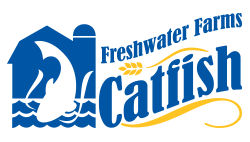Resources

FAQs
U.S. Farm-Raised Catfish is known for its consistency. Achieving that consistency begins with the selection and mating of mature catfish. Mature catfish remain in production an average of 4 to 6 years, depending on where they are grown, and lay 3,000 to 4,000 eggs annually per pound of body weight. Once the eggs are laid and fertilized, they are collected and taken to special hatcheries designed to replicate the natural environment. The eggs hatch after seven days and move to the next level of maturation, called “sac fry” because of the attached yolk sacs that supply their food.
Soon, the tiny U.S. Farm-Raised Catfish begin to swim and are moved to special ponds, where they grow into fingerlings. When the fingerlings are about 4 to 6 inches long (the size of an index finger), they are placed in manmade ponds filled with fresh water pumped from underground wells.
After 18 months to two years, or when the U.S. Farm-Raised Catfish reach about 1 pound each, they are harvested with seines (large weighted nets) and loading baskets, then taken to processing plants in aerated tank trucks.
Once the U.S. Farm-Raised Catfish reach the plants, the entire production process takes less than 30 minutes, making top-quality, U.S. Farm-Raised Catfish among the freshest fish available. The catfish is cleaned, processed, and placed on ice or frozen to a temperature of 40 degrees below zero using an individually quick-frozen (IQF) method that preserves the taste and quality of the fish. U.S. Farm-Raised Catfish is then sold as whole fish, steaks, fillets, strips and nuggets, as well as marinated and prebreaded or precooked in frozen dinners.
It takes about 18 months to two years to grow a 1-pound fish.
A full-grown fish averages between 1 and 2 pounds.
The largest ingredient in the feed is soybean meal, with some corn and rice ingredients. The feed is routinely assayed for moisture, protein, fat and fiber, and periodically for selected micronutrients to ensure nutritional value. Each batch of feed is checked for physical characteristics, including floatability.
U.S. Farm-Raised Catfish is raised in environmentally controlled, clay-based ponds, filled with fresh water pumped from underground wells and filtered by alluvial aquifers. The average pond, constructed by building above-ground levees to serve as natural barriers, is 10 to 20 land acres in area and 4 to 6 feet deep. The fish are fed a scientifically formulated diet of high-protein pellets that float on top of the water. U.S. Farm-Raised Catfish is subject to Hazard Analysis & Critical Control Point Program (HACCP) regulations and is inspected by the U.S. Department of Commerce at the processing plants before it can carry the Certified Processors seal, confirming it has met the highest standards set by The Catfish Institute.
Fish tends to adopt the flavor characteristics of what they eat. Because U.S. Farm-Raised Catfish is fed a scientifically formulated diet of high-protein pellets that float on top of the water, it has a consistently mild, slightly sweet flavor.
U.S. Farm-Raised Catfish is a lean fish and an excellent source of protein. It is low in saturated (bad) fat and is a moderate source of polyunsaturated (good) fat and omega-3 fatty acids. According to a study published in the Journal of the American Medical Association, moderate fish consumption one to two meals a week may cut the risk of sudden cardiac death in half. The results show that any kind of fish, including U.S. Farm-Raised Catfish, can make a difference.
U.S. Farm-Raised Catfish is a sustainable and environmentally friendly seafood product. The National Audubon Society, Monterey Bay Aquarium, and Environmental Defense all recommend U.S. Farm-Raised Catfish as a safe environmental choice.
U.S. Farm-Raised Catfish is not given any added hormones. Under normal growing conditions, U.S. Farm-Raised Catfish is antibiotic-free; only in rare instances when medication is required to treat an illness is U.S. Farm-Raised Catfish treated with a necessary dose of antibiotics.
There is no iodine added to the feed or the water of U.S. Farm-Raised Catfish.
To ensure safe animal feed, all U.S. livestock feed products, which include feed for beef, poultry, pork, and catfish, are regulated by the Federal Drug Administration’s Center for Veterinary Medicine. According to the U.S. Department of Agriculture, about three-fourths of all U.S. corn, and a higher percentage of all U.S. soybeans, are grown from genetically modified seeds. These grains are the primary content of feed used by U.S. Catfish farmers, and other U.S. livestock industries. The U.S. Catfish Industry is committed to the highest quality standards in growing, harvesting, and processing their product, so when the consumer purchases catfish products labeled “U.S. Farm-Raised Catfish,” they can be guaranteed they will enjoy a catfish that is both safe and delicious.
Industry Resources

The Catfish Institute

Best Aquaculture Practices
BAP is the world’s most trusted, comprehensive and proven third-party aquaculture certification program. We’ve been improving the environmental, social and economic performance of the aquaculture supply chain and growing the global supply of responsibly farmed seafood since 2002. | View Website
